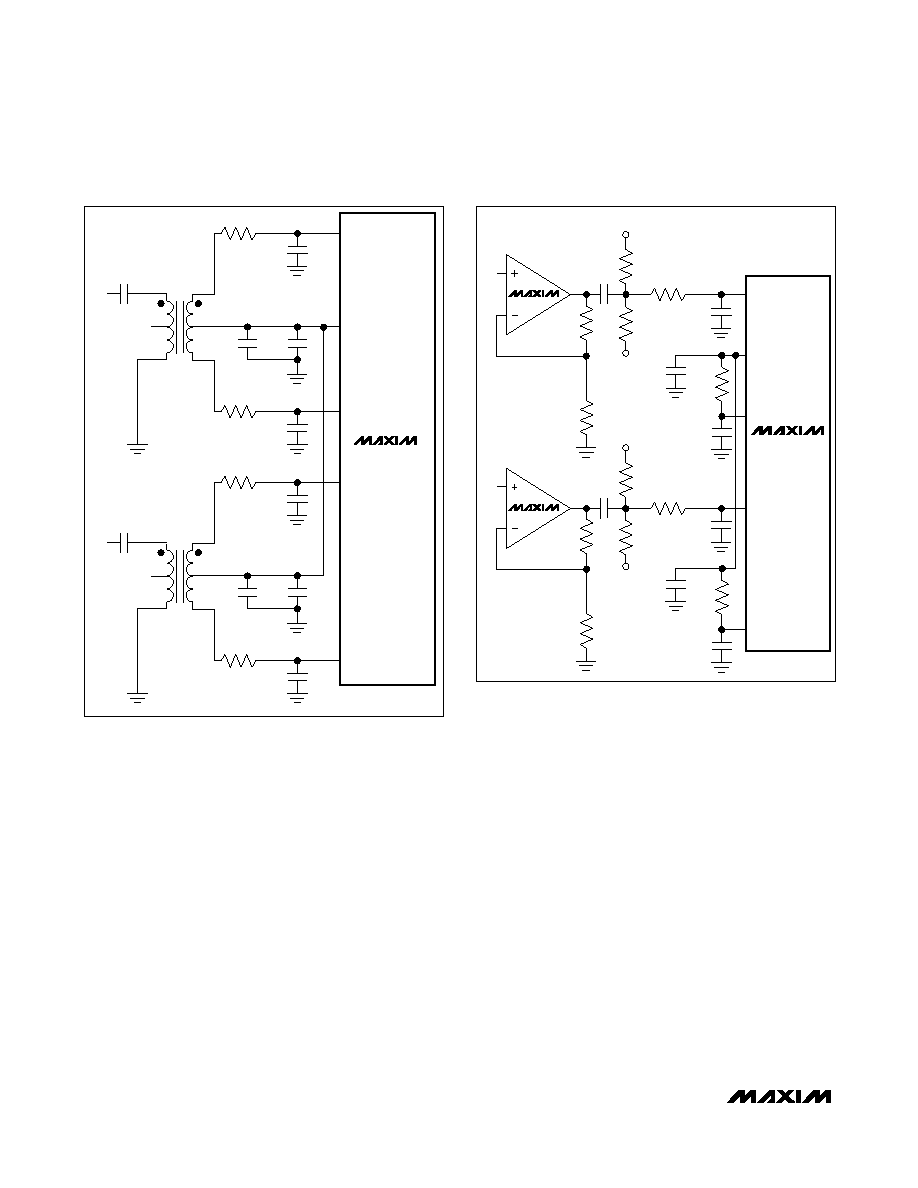- 您现在的位置:买卖IC网 > Sheet目录2008 > MAX1184ECM+TD (Maxim Integrated Products)IC ADC 10BIT 20MSPS DL 48-TQFP

MAX1184
Dual 10-Bit, 20Msps, 3V, Low-Power ADC with
Internal Reference and Parallel Outputs
16
______________________________________________________________________________________
MAX1184
0.1
F
1k
1k
100
100
CIN
22pF
CIN
22pF
INB+
INB-
COM
INA+
INA-
0.1
F
RISO
50
RISO
50
REFP
REFN
VIN
MAX4108
0.1
F
1k
1k
100
100
CIN
22pF
CIN
22pF
0.1
F
RISO
50
RISO
50
REFP
REFN
VIN
MAX4108
Figure 7: Using an Op Amp for Single-Ended, AC-Coupled
Input Drive
Using Transformer Coupling
A RF transformer (Figure 6) provides an excellent solu-
tion to convert a single-ended source signal to a fully
differential signal, required by the MAX1184 for opti-
mum performance. Connecting the center tap of the
transformer to COM provides a VDD/2 DC level shift to
the input. Although a 1:1 transformer is shown, a step-
up transformer may be selected to reduce the drive
requirements. A reduced signal swing from the input
driver, such as an op amp, may also improve the over-
all distortion.
In general, the MAX1184 provides better SFDR and
THD with fully-differential input signals than single-
ended drive, especially for very high input frequencies.
In differential input mode, even-order harmonics are
lower as both inputs (INA+, INA- and/or INB+, INB-) are
balanced, and each of the ADC inputs only requires half
the signal swing compared to a single-ended mode.
Single-Ended AC-Coupled Input Signal
Figure 7 shows an AC-coupled, single-ended applica-
tion. Amplifiers like the MAX4108 provide high speed,
high bandwidth, low noise, and low distortion to main-
tain the integrity of the input signal.
Figure 6. Transformer-Coupled Input Drive
MAX1184
T1
N.C.
VIN
6
1
5
2
4
3
22pF
0.1
F
0.1
F
2.2
F
25
25
MINICIRCUITS
TT1–6
T1
N.C.
VIN
6
1
5
2
4
3
22pF
0.1
F
0.1
F
2.2
F
25
25
MINICIRCUITS
TT1–6
INA-
INA+
INB-
INB+
COM
发布紧急采购,3分钟左右您将得到回复。
相关PDF资料
MAX1186ECM+TD
IC ADC 10BIT 40MSPS DL 48-TQFP
MAX1187CCUI+
IC ADC 16BIT 135KSPS 28-TSSOP
MAX118EAI+
IC ADC 8BIT 1MSPS 28-SSOP
MAX1191ETI+T
IC ADC 8BIT 7.5MSPS DL 28-TQFN
MAX1192ETI+T
IC ADC 8BIT 22MSPS DL 28-TQFN
MAX1195ECM+TD
IC ADC 8BIT 40MSPS DL 48-TQFP
MAX1197ECM+TD
IC ADC 8BIT 60MSPS DL 48-TQFP
MAX1202AEPP+
IC ADC 12BIT 8CH 20-DIP
相关代理商/技术参数
MAX1184ECM-D
功能描述:模数转换器 - ADC RoHS:否 制造商:Texas Instruments 通道数量:2 结构:Sigma-Delta 转换速率:125 SPs to 8 KSPs 分辨率:24 bit 输入类型:Differential 信噪比:107 dB 接口类型:SPI 工作电源电压:1.7 V to 3.6 V, 2.7 V to 5.25 V 最大工作温度:+ 85 C 安装风格:SMD/SMT 封装 / 箱体:VQFN-32
MAX1184ECM-T
制造商:Maxim Integrated Products 功能描述:DUAL 10-BIT, 20MSPS, +3V, LOW-POWER ADC WITH - Tape and Reel
MAX1184ECM-TD
功能描述:模数转换器 - ADC RoHS:否 制造商:Texas Instruments 通道数量:2 结构:Sigma-Delta 转换速率:125 SPs to 8 KSPs 分辨率:24 bit 输入类型:Differential 信噪比:107 dB 接口类型:SPI 工作电源电压:1.7 V to 3.6 V, 2.7 V to 5.25 V 最大工作温度:+ 85 C 安装风格:SMD/SMT 封装 / 箱体:VQFN-32
MAX11850ETM+
功能描述:触摸屏转换器和控制器
RoHS:否 制造商:Microchip Technology 类型:Resistive Touch Controllers 输入类型:3 Key 数据速率:140 SPS 分辨率:10 bit 接口类型:4-Wire, 5-Wire, 8-Wire, I2C, SPI 电源电压:2.5 V to 5.25 V 电源电流:17 mA 工作温度:- 40 C to + 85 C 封装 / 箱体:SSOP-20
MAX11850ETM+T
功能描述:触摸屏转换器和控制器
RoHS:否 制造商:Microchip Technology 类型:Resistive Touch Controllers 输入类型:3 Key 数据速率:140 SPS 分辨率:10 bit 接口类型:4-Wire, 5-Wire, 8-Wire, I2C, SPI 电源电压:2.5 V to 5.25 V 电源电流:17 mA 工作温度:- 40 C to + 85 C 封装 / 箱体:SSOP-20
MAX11850GTM+
功能描述:触摸屏转换器和控制器
RoHS:否 制造商:Microchip Technology 类型:Resistive Touch Controllers 输入类型:3 Key 数据速率:140 SPS 分辨率:10 bit 接口类型:4-Wire, 5-Wire, 8-Wire, I2C, SPI 电源电压:2.5 V to 5.25 V 电源电流:17 mA 工作温度:- 40 C to + 85 C 封装 / 箱体:SSOP-20
MAX11850GTM+T
功能描述:触摸屏转换器和控制器
RoHS:否 制造商:Microchip Technology 类型:Resistive Touch Controllers 输入类型:3 Key 数据速率:140 SPS 分辨率:10 bit 接口类型:4-Wire, 5-Wire, 8-Wire, I2C, SPI 电源电压:2.5 V to 5.25 V 电源电流:17 mA 工作温度:- 40 C to + 85 C 封装 / 箱体:SSOP-20
MAX11850HTEVS+
功能描述:数据转换 IC 开发工具 RoHS:否 制造商:Texas Instruments 产品:Demonstration Kits 类型:ADC 工具用于评估:ADS130E08 接口类型:SPI 工作电源电压:- 6 V to + 6 V